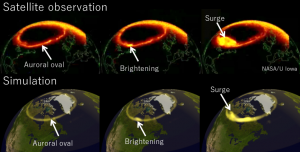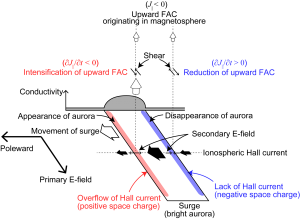Yusuke Ebihara (RISH, Kyoto University)
A substorm is a transient, comprehensive phenomenon taking place in the magnetosphere and the ionosphere. The bright aurora traveling westward, called an auroral surge, is a manifestation of the substorm. When the substorm occurs, the magnetosphere and the ionosphere are highly disturbed. For example, hot plasma is transported from the plasma sheet toward the Earth, being a seed of the radiation belt and the ring current. In the ionosphere, more than 1011 W of energy is consumed at once. Because of the significant influence of the substorm on the state of the magnetosphere and the ionosphere, we need to understand the substorm properly.
Prime questions regarding the auroral surge are: Why does the surge travel westward? Why is the aurora extremely brightened? We analyzed the simulation results of the global magnetohydrodynamics (MHD) simulation developed by Professor Emeritus Tanaka (Figure 1). The following are the result of the analysis (Figure 2):
1. Magnetic reconnection takes place in the magnetotail on the nightside. Shear motion of plasma occurs at high-altitude magnetosphere.
2. Upward field-aligned current (FAC) is generated. When the FAC is connected to the ionosphere, the aurora becomes bright. (The ionospheric conductivity increases.)
3. The ionospheric Hall current in the bright aurora is higher than ambient. The Hall current overflows near the edge of the bright aurora, giving rise to positive space charge. (Divergent electric field appears.)
4. Flow shear associated with the divergent electric field occurs at low-altitude magnetosphere.
5. Upward FAC is intensified.
6. Aurora is brightened.
7. On the opposite side, opposite processes take place. The Hall current lacks, giving rise to negative space charge. (Convergent electric field appears.)
8. Flow shear associated with the convergent electric field occurs at low-altitude magnetosphere.
9. Upward FAC is degraded.
10. Aurora becomes bright on one side of the surge, and becomes dimming on the other side of the surge. By repeating these processes, the surge travels westward or poleward.

Figure 1: (top) Auroral breakup observed by a satellite, and (bottom) auroral breakup simulated by the global MHD simulation.

Figure 2: Schematic drawing of the surge, the ionospheric Hall current, and the convection electric field. (After Ebihara and Tanaka, 2018)
Reference:
Ebihara, Y., and T. Tanaka, Why does substorm-associated auroral surge travel westward?, Plasma Physics and Controlled Fusion, 60 014024, doi:10.1088/1361-6587/aa89fd, 2018.
